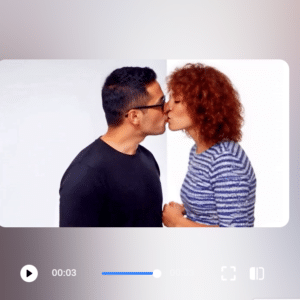AI Livestreams vs. Pre-recorded Demos
AI Livestreams vs Pre-recorded Demos: What does the future hold?
With the rise of AI in virtually every industry, effectively demonstrating these technologies has become essential for businesses. Whether launching a new feature or explaining a complex capability, choosing the right demo format can impact how well your audience understands and values your AI product.
Today, two main formats lead the way: livestreams and pre-recorded demos. But which one is best for capturing attention, providing insights, and building trust?
In this post, we’ll explore the strengths and limitations of each approach, and help you decide which demo style is right for showcasing your AI solution and also delve into what the future holds for these tools.

AI Livestreams vs. Pre-recorded Demos
Understanding the Formats
What is a Livestream Demo? A livestream demo is a real-time broadcast where presenters demonstrate AI features or answer audience questions as they come in. These sessions are interactive, often allowing viewers to engage with presenters directly. Livestreams are dynamic and can be adapted on the fly, making them feel more authentic and immediate.
What is a Pre-recorded Demo? In contrast, a pre-recorded demo is a carefully crafted video that’s planned, filmed, and edited before sharing with an audience. Pre-recorded demos allow for meticulous control over content, timing, and quality. They’re typically designed for viewing at any time and offer a polished, streamlined viewing experience.
Pros and Cons of AI Livestream Demos
Advantages:
- Real-time Engagement: Livestream demos offer instant interaction. Audience members can ask questions during the demo, creating a sense of connection and immediacy that fosters trust.
- Spontaneity and Authenticity: Livestreams feel more organic. Viewers see genuine reactions from presenters and may feel more confident in the product’s authenticity.
- Flexibility to Pivot: In a livestream, presenters can quickly adapt to address audience questions or interests, making it possible to focus on high-priority features in real-time.
Disadvantages:
- Technical Glitches: Internet issues, platform problems, or unexpected software errors can disrupt a livestream, which may hurt viewer confidence.
- High Pressure: For complex AI demos, managing everything live can be challenging, especially if multiple technical components are involved.
- Reliance on Strong Connectivity: A successful livestream requires reliable internet and streaming capabilities, both from the presenter and the audience side.
check out Harvard’s Tips for Making Educational Videos.
Pros and Cons of AI Pre-recorded Demos
Advantages:
- High-Quality Production: With the ability to edit, pre-recorded demos ensure polished presentations, with music, transitions, and professional-quality visuals.
- Full Control Over Narrative: Pre-recorded content lets creators carefully script and rehearse the demo, allowing a clear storyline and controlled pace.
- Reduced Technical Risk: Pre-recording eliminates the uncertainty of real-time streaming. Issues can be fixed in editing, ensuring a smooth viewing experience.
Disadvantages:
- Limited Real-Time Interaction: Pre-recorded demos miss the immediacy of live engagement, which can make it harder to connect with the audience directly.
- Less Authentic Feel: Some viewers may feel that pre-recorded demos are overly polished, reducing the sense of spontaneity and authenticity.
- No Immediate Feedback or Q&A: Without live questions, any follow-up must happen separately, often limiting the direct responses that audiences find valuable.
When to Use Livestreams vs. Pre-recorded Demos
Best Scenarios for Livestreams:
- Product Launches and Announcements: Use livestreams to generate excitement around a new feature or release. Viewers can ask questions and get immediate answers, driving engagement.
- Real-time Engagement with Customers: For products where customer feedback shapes the development, livestreams allow for valuable live exchanges.
- Demonstrating New or Updated Features: Livestreams let presenters focus on popular features or troubleshoot live to address customer pain points.
Best Scenarios for Pre-recorded Demos:
- Tutorials and Step-by-Step Walkthroughs: When teaching users how to use an AI product, pre-recorded demos offer consistency and control, making it easier to follow.
- Complex Technical Features: If explaining intricate details, pre-recorded content allows for a clear, polished, and error-free presentation that’s less prone to live issues.
- On-demand Viewing: When creating content to be accessed over time, pre-recorded demos ensure that viewers can learn at their own pace.
AI Livestreams vs Pre-recorded DemosAudience Engagement and Interaction
Livestreams naturally offer more interaction since viewers can ask questions and get real-time responses. To maximize engagement in a livestream, consider including live polls, quizzes, and Q&A segments to capture attention and address viewer curiosity.
Pre-recorded demos can still foster engagement by including a Q&A section in the comments or links to additional resources and live support options. Encourage viewers to comment and interact with each other to build a sense of community around the content.
Case Studies / Examples
Example of a Successful AI Livestream Demo: A tech company recently launched a new AI-driven software tool via livestream. The presenter demonstrated key features while responding to live questions from an audience of developers and tech enthusiasts. This format provided an engaging and personal touch, leading to a spike in sign-ups immediately after the event.
Example of a Successful Pre-recorded AI Demo: A company specializing in AI-based data analytics created a pre-recorded tutorial series for new customers.
Each video focused on specific use cases and demonstrated how to utilize the platform for various industries. The high-quality production and clear explanations received positive feedback, and the videos became a helpful resource for new customers.
These examples illustrate how each format can effectively reach and resonate with a target audience under different conditions.
Live AI Demonstrations vs. Traditional Pre-recorded Presentations: Which is More Effective?
With AI advancements happening rapidly, companies and educators often need to demonstrate their capabilities to potential users and learners in a way that is both informative and engaging.
Live AI demonstrations and pre-recorded presentations serve distinct purposes in showcasing AI technology, each offering unique advantages. Let’s dive into the effectiveness of each approach and explore the value of live streams that emphasize community interaction through Q&A sessions, live coding, and collaborative projects.
1. Engagement and Interactivity
Live AI Demonstrations: Live demonstrations create a direct and dynamic connection with the audience. By incorporating live Q&A sessions, real-time coding, and collaborative projects, presenters make it possible for viewers to ask questions and get instant responses, making the experience feel personal and engaging.
This type of interaction is particularly valuable in the AI field, where concepts can be complex and audience members often need clarification or elaboration. In addition, live coding sessions allow the audience to observe both successes and challenges in real-time, giving them insight into how AI models are developed and deployed.
- Pros: Interactive, immediate feedback, real-time troubleshooting, and engagement through collaborative activities.
- Cons: Requires strong internet and tech support, and is vulnerable to technical glitches, which can disrupt the presentation flow.
Pre-recorded Presentations: Pre-recorded presentations, while lacking interactivity, allow presenters to focus on delivering a flawless, uninterrupted presentation.
These videos can be edited for clarity and conciseness, reducing unnecessary content and ensuring that complex AI concepts are communicated clearly. Additionally, the ability to replay sections means viewers can watch at their own pace, which is useful for absorbing complex information.
- Pros: High production quality, easy to follow, error-free content.
- Cons: Lacks direct interaction, no real-time answers, and may feel more detached.
2. Audience Learning Experience
Live AI Demonstrations: For learners, a live demo provides an opportunity to participate actively rather than just observe passively. Q&A sessions allow learners to direct the discussion based on their interests or questions, fostering a deeper understanding of AI concepts.
Furthermore, collaborative coding sessions provide hands-on experience that is often crucial in AI and machine learning education, where seeing real-world applications and solutions is highly beneficial.
- Benefits in AI Education: Viewers see how models work in practice, gain insights into the debugging process, and understand real-world problem-solving. This format is ideal for collaborative learning, with immediate feedback helping learners to solidify concepts.
Pre-recorded Presentations: These are often ideal for structured learning, where viewers need to absorb foundational knowledge at their own pace. Pre-recorded sessions are well-suited for complex AI topics, as they can include high-quality visuals, graphics, and animations that simplify explanations and make it easier for learners to grasp intricate concepts.
However, while this approach provides excellent content structure, it lacks the opportunity for live problem-solving and real-time clarification.
- Benefits in AI Education: Pre-recorded presentations are effective for initial introductions to topics, detailed explanations, and reviewing at one’s own pace. This format is especially valuable for audiences looking for clear, polished material.
3. Community Building and Collaboration
Live AI Demonstrations: The real strength of live demos lies in their potential to foster community. AI live streams that incorporate collaborative projects, hackathons, or live coding sessions offer a unique space where participants work together to build something.
This community-driven approach can strengthen relationships among viewers and between the audience and presenter, creating a learning community around shared interests.
Live Q&A sessions or polls also allow presenters to gauge audience sentiment and adjust the content on the fly, leading to a more audience-focused experience.
- Community Benefits: Audience members feel more connected to the material and the presenter, which can foster a sense of belonging. These events often result in ongoing discussions and the development of networks that benefit both the organization and the attendees.
Pre-recorded Presentations: While pre-recorded sessions are not interactive, they can still foster a form of community engagement through comments and discussion boards. Many educational platforms or content creators use this format to build communities asynchronously, encouraging viewers to discuss or ask questions post-session.
However, this engagement typically lacks the immediacy and collaborative feel of live interaction, and can lead to a more passive, individual experience.
- Community Benefits: Well-organized pre-recorded content can serve as a long-term resource, bringing learners together to discuss concepts at their own pace. However, it requires supplementary community-building strategies (e.g., forums, follow-up Q&As) to facilitate deeper connections.
4. Technical Transparency and Trust-Building
Live AI Demonstrations: One of the key benefits of live demos is transparency. Viewers get to see the AI in action, including any unexpected behavior, challenges, or bugs that may arise.
This transparency helps build trust, as it shows the technology in an authentic setting. Additionally, real-time problem-solving, such as debugging or optimizing code, reveals the expertise of the presenters, further establishing credibility and trust in the brand or instructor.
- Trust Benefits: Viewers appreciate seeing both the strengths and limitations of AI technology live. This format builds authenticity and shows the audience that they are seeing the “real deal,” not a pre-polished version.
Pre-recorded Presentations: Pre-recorded presentations, while professional and polished, do not provide the same level of transparency.
They’re edited to show only the best, most prepared version of the technology, which can sometimes feel staged.
However, they are useful for cases where presenting an idealized or polished product is necessary, particularly when targeting clients or executives who may prioritize functionality over process transparency.
- Trust Benefits: While polished, pre-recorded presentations may lack the “rawness” of live events, they effectively communicate an organization’s commitment to high quality. They work well for presenting high-stakes demonstrations or project outcomes where reliability is paramount.
5. Choosing the Right Format for Your AI Showcase
When to Choose Live AI Demonstrations:
- When fostering engagement and community is key: For tech-savvy audiences who appreciate interaction and the opportunity to engage directly.
- For tutorials, Q&As, or coding sessions: To provide hands-on learning experiences and interactive exploration of technical topics.
- When transparency builds trust: If you want to show the realistic process of working with your AI technology, including potential issues and solutions.
When to Choose Pre-recorded Presentations:
- For structured, polished education: When aiming to create clear, high-quality material, especially for complex or detail-heavy topics.
- For content that needs replayability: When your audience may benefit from re-watching to fully grasp complex AI concepts.
- When targeting an audience that prioritizes professionalism: Ideal for high-stakes presentations where a refined and seamless delivery is expected.
Conclusion
Both live AI demonstrations and pre-recorded presentations offer unique advantages. Live demos are ideal for engagement, transparency, and community building, providing audiences with an authentic, real-time experience.
In contrast, pre-recorded presentations excel at delivering polished, structured content and are highly suitable for complex topics where consistent quality is essential.
By carefully choosing the format that best suits your audience’s needs and your presentation goals, you can ensure your AI technology is showcased in the most effective way possible.


















